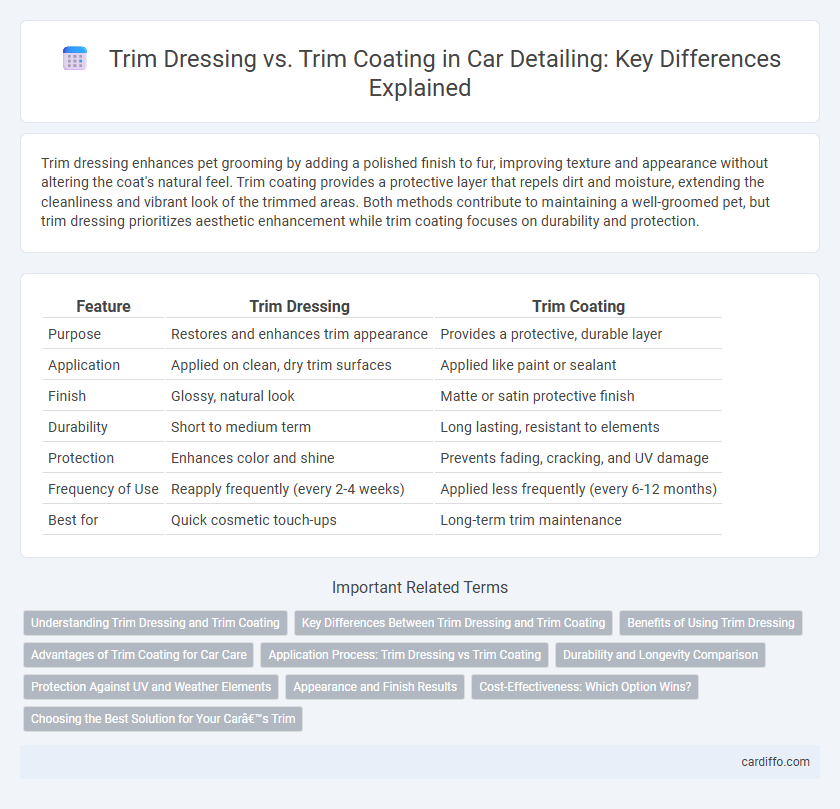Trim dressing enhances pet grooming by adding a polished finish to fur, improving texture and appearance without altering the coat's natural feel. Trim coating provides a protective layer that repels dirt and moisture, extending the cleanliness and vibrant look of the trimmed areas. Both methods contribute to maintaining a well-groomed pet, but trim dressing prioritizes aesthetic enhancement while trim coating focuses on durability and protection.
Table of Comparison
| Feature | Trim Dressing | Trim Coating |
|---|---|---|
| Purpose | Restores and enhances trim appearance | Provides a protective, durable layer |
| Application | Applied on clean, dry trim surfaces | Applied like paint or sealant |
| Finish | Glossy, natural look | Matte or satin protective finish |
| Durability | Short to medium term | Long lasting, resistant to elements |
| Protection | Enhances color and shine | Prevents fading, cracking, and UV damage |
| Frequency of Use | Reapply frequently (every 2-4 weeks) | Applied less frequently (every 6-12 months) |
| Best for | Quick cosmetic touch-ups | Long-term trim maintenance |
Understanding Trim Dressing and Trim Coating
Trim dressing involves applying a protective or decorative layer to trim surfaces, enhancing durability and aesthetic appeal by sealing and finishing the material. Trim coating refers to the process of covering trim with a specialized coating that provides additional protection against environmental factors, such as moisture and UV damage, while improving surface uniformity. Both methods contribute to extending the lifespan and appearance of trim in automotive and architectural detailing.
Key Differences Between Trim Dressing and Trim Coating
Trim dressing primarily serves as a protective sealant that enhances the surface durability of wooden trims, preventing moisture penetration and minor surface damage. Trim coating, in contrast, involves applying a layer of paint or stain that not only protects but also significantly alters the aesthetic appearance with color and finish options. The key difference lies in trim dressing's focus on surface treatment and protection, whereas trim coating emphasizes both protection and decorative enhancement.
Benefits of Using Trim Dressing
Trim dressing enhances the appearance of vehicle trim by restoring color and providing a long-lasting, rich finish that resists fading and cracking. Its formulation protects against UV damage, dirt accumulation, and water intrusion, extending the lifespan of the trim. Unlike trim coating, trim dressing often requires less preparation and dries faster, making it a convenient and effective solution for maintaining vehicle aesthetics.
Advantages of Trim Coating for Car Care
Trim coating offers superior long-lasting protection against UV rays, preventing fading and discoloration on car trim surfaces. Its advanced formula provides a durable, water-repellent barrier that helps resist dirt, grime, and oxidation more effectively than traditional trim dressing. This results in enhanced aesthetic appeal and reduced maintenance frequency, preserving the vehicle's value over time.
Application Process: Trim Dressing vs Trim Coating
Trim dressing involves an easy application process using a spray or wipe-on method that quickly enhances the appearance of rubber, vinyl, and plastic surfaces with a wet or satin finish. Trim coating, meanwhile, requires a more detailed application involving brushes or rollers to create a durable, protective layer that restores texture and color to faded trim. Both methods improve vehicle aesthetics, but trim coating offers longer-lasting protection compared to the quicker, more cosmetic effect of trim dressing.
Durability and Longevity Comparison
Trim coating provides superior durability compared to trim dressing, as it forms a thicker, more resilient layer that protects underlying surfaces from wear, moisture, and UV damage. The longevity of trim coating typically extends several years longer than trim dressing due to its enhanced resistance to cracking, fading, and peeling. While trim dressing offers a quicker, easier application, trim coating is preferable for maintaining trim integrity and appearance over extended periods.
Protection Against UV and Weather Elements
Trim dressing provides a protective layer that enhances the durability of automotive trim by shielding it from UV rays and harsh weather conditions, preventing fading and cracking. Trim coating offers a more robust barrier through advanced polymers that repel moisture, resist oxidation, and maintain color vibrancy over time. Both treatments extend the lifespan of exterior trim, but trim coating typically delivers superior protection against prolonged exposure to sunlight and environmental stressors.
Appearance and Finish Results
Trim dressing enhances appearance by applying a base coat that seals and smooths surfaces, ensuring better adhesion for subsequent layers. Trim coating involves layering thicker finishes, providing a more polished, durable, and uniform surface with richer texture and gloss. The choice between dressing and coating directly affects the final finish quality, with coating delivering superior protection and aesthetic appeal.
Cost-Effectiveness: Which Option Wins?
Trim dressing generally offers a more cost-effective solution compared to trim coating, as it involves minimal labor and material expenses while maintaining trim integrity. Trim coating requires specialized paint products and skilled application, increasing overall costs but providing enhanced durability and aesthetic appeal. Evaluating project size and desired finish quality helps determine the most economical choice between these two options.
Choosing the Best Solution for Your Car’s Trim
Trim dressing enhances your car's exterior by restoring color and providing a glossy finish that protects rubber and plastic surfaces from UV damage. Trim coating offers a more durable solution by creating a long-lasting, protective barrier resistant to fading, cracking, and environmental contaminants. Choosing between trim dressing and trim coating depends on your desired level of protection and maintenance frequency, with trim coating preferred for long-term durability and trim dressing ideal for quick, aesthetic touch-ups.
Trim Dressing vs Trim Coating Infographic

 cardiffo.com
cardiffo.com